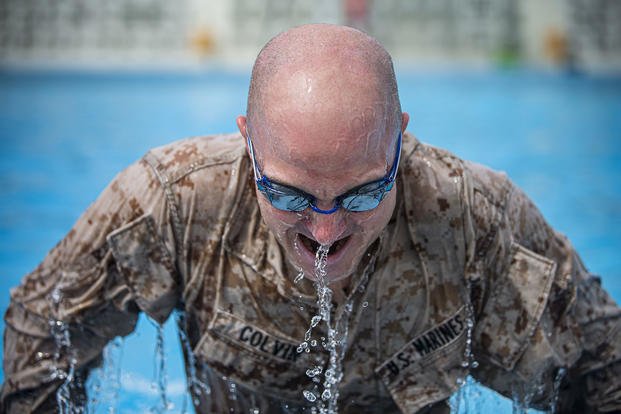Marines are known as amphibious warriors based on their ability to assault fortified islands by sea.
During past amphibious assaults, some Americans have lost their lives by drowning in the surf. To give Marines a basic understanding of how to survive the watery forces of nature, they must qualify in Combat Water Survival training during boot camp. Company D recruits earned their qualifications in the first phase of boot camp March 10.
Combat Water Survival training is designed to reduce the fear of water, instill self-confidence and develop the ability to survive in aquatic environments, said Gunnery Sgt. Christopher Glocke, chief swim instructor and company gunnery sergeant for Instructional Training Company.
"We are a military branch capable of fighting on all fronts," said Sgt. Kendall Wright, drill instructor, Platoon 1063, Company D. "This training is important because if we do not have water survival skills, we will not be as successful (when attacking from the sea)."
Recruits are required to perform several tasks in the water. They swim specific distances, tread water and rescue teammates.
"During this training, they learn basic water survival skills," Glocke said. "The training is not that hard. It helps recruits feel more confident in the water, which is one of the most important things because it teaches recruits to relax, breathe and survive."
Recruits begin the course with CWS-4 qualification, the minimum qualification requirement for enlisted Marines, which focuses on personal survival without combat gear.
At this level, recruits swim 25 meters in shallow water, using the beginner or survival stroke. They also are required to enter the pool from a 15-foot tower, simulating the abandon ship technique. After returning to the surface, they swim to an area where they tread water for four minutes. Recruits then swim another 25 meters to obtain the minimum requirement for graduation.
Rescue Swimmer Fitness Standards
After recruits complete the requirements for CWS-4, they move on to the more difficult third and second classes, which involve full combat gear.
"I've always been a good swimmer because I grew up near the beach," said Recruit James Clancy, Platoon 1063. "My preconceived notions were the most challenging. I didn't think it was possible to swim with all the gear, and I worried that the gear would drag me under the water."
The third-class qualification begins with recruits entering the water, using the abandon ship technique and swimming 25 meters. Recruits then don full combat gear, enter shallow water and swim 40 meters to the other side of the pool.
Recruits again enter the pool using the abandon ship technique, only this time from an eight-foot tower while wearing full combat gear. One final 25-meter swim completes the third-class qualification.
The second-class water survival qualification is the last level that recruits can obtain in boot camp. The qualification focuses on assisting an exhausted or wounded Marine to safety while wearing full combat gear.
After swimming 50 meters, recruits drag other recruits, simulating wounded Marines, 25 meters to earn the second-class qualification.
"As Marines, we will be put in situations where this training will save our lives," Wright said.
Interested in joining the Marine Corps?
Want to Learn More About Military Life?
Whether you're thinking of joining the military, looking for fitness and basic training tips, or keeping up with military life and benefits, Military.com has you covered. Subscribe to Military.com to have military news, updates and resources delivered directly to your inbox.


















